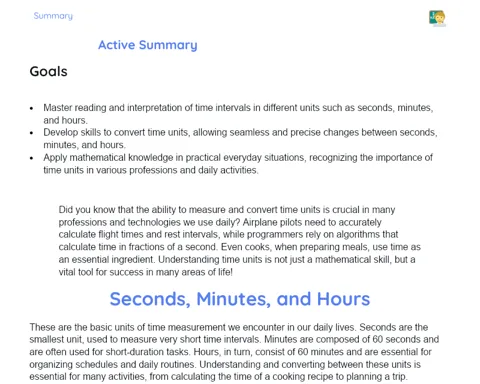Introduction
Relevance of the Topic
The Circle Area is a crucial content within Plane Geometry, one of the main segments of mathematics. Knowing how to calculate the area of a circle is essential for understanding various phenomena and practical applications in various fields such as Engineering, Architecture, and Physics. This skill, besides promoting critical thinking, is required in situations ranging from taking exams and competitions to solving everyday problems.
Contextualization
Among the basic elements of the circle, consisting of radius, diameter, circumference, and area, the Circle Area has a special meaning: it is the amount of space it occupies on a flat surface. The calculation of this area is a direct consequence of the relationship between the circumference and its diameter, expressed by the number pi (π), with the formula for calculating the area derived from it: A = π*r², where A is the area and r is the radius of the circle.
Knowing this formula opens up a range of possibilities for solving practical problems. This connects with other topics in the curriculum, such as the study of geometric solids — where the circle is the base for the creation of cylinders and cones, for example — and the introduction to integral calculus. Understanding the Circle Area is, therefore, a very important step in becoming well-versed in the universal language that is mathematics.
Theoretical Development
Components
-
Pi Number (π): It is the relationship between the circumference and its diameter. In other words, it is the ratio of the circumference length to its diameter. Regardless of the size of the circumference, this ratio will always be approximately 3.14.
-
Radius (r): It is any line segment that connects the center of the circle to any point on its circumference. The length of the radius is essential for calculating the area of the circle.
-
Circle: It is the set of all points in a plane that are at the same distance from a fixed point called the center. The distance from any point on the circle to the center is the radius.
-
Area (A): It is the amount of space occupied by a surface. In the case of a circle, the area can be calculated by the formula A = π*r², where r represents the radius.
Key Terms
-
Circumference: It is the curved, closed, and flat line formed by equidistant points from a fixed central point.
-
Diameter (D): It is a line segment that passes through the center of the circle and has its ends on the circumference. The diameter is equal to twice the radius (D = 2r).
-
Flat Surface: It is a surface that can be covered by lines in all directions, without elevations or depressions.
Examples and Cases
-
Example 1 – Calculating the Area of a Circle with Known Radius: Suppose a circle where the radius measures 5 cm. Applying the formula A = π*r², we find that the area of the circle is 78.54 cm².
-
Case 2 – Practical Problem: A pizza has a diameter of 30 cm. We want to calculate the area occupied by each slice if the pizza is divided into 8 equal parts. First, we calculate the total area of the pizza: as D = 2r, the radius will be 15 cm. Therefore, the total area is π*15² = 706.86 cm². Dividing this value by 8, each slice will have an area of 88.36 cm².
-
Example 3 – Connection with Other Mathematical Concepts: The circle is the basis for the creation of other geometric elements, such as cylinders and cones. For example, in a cylinder, the area of the base (a circle) is essential for volume and total surface area calculations.
Detailed Summary
Relevant Points
-
Pi Number (π): Always present in measurement formulas involving the circle, the number pi is a mathematical constant that represents the relationship between the circumference and its diameter. Fundamentally irrational and transcendental, it is approximated to 3.14 for practical calculations.
-
Circle and its Components: To calculate the area of the circle, it is crucial to understand and identify its components, specifically the radius (r) – the distance from the center of the circle to any point on its circumference.
-
Circle Area Formula: The formula (A = π*r²) is the key to calculating the area of the circle. Through it, one can obtain the exact measurement of the flat surface occupied by the circle from the radius.
Conclusions
-
Deep Understanding of the Circle: Through the study of the circle area, the understanding of how this basic shape interacts with space is deepened. The area is a fundamental concept in many disciplines and practical applications, revealing the versatility of studying the circle.
-
The Importance of Pi Number: The value of pi is intrinsic to any circle, being an essential part of its metric properties. Incorporating it into the area calculation reinforces students' understanding of its universal presence in circular measurements.
-
Derivation of Other Mathematical Concepts: The circle area is not limited to the plane. It is a fundamental piece for calculating the surface and volume of solids of revolution such as cylinders and cones, indicating the relevance of this concept for more advanced topics.
Exercises
-
Exercise 1: Calculate the area of a circle with a radius of 10 centimeters.
-
Exercise 2: In a circle with a radius of 7 meters, what is the difference in area if we increase the radius by 10%?
-
Exercise 3: Given a 32 cm diameter pizza, if a person eats 2/8 (a quarter) of it, what will be the consumed area?



